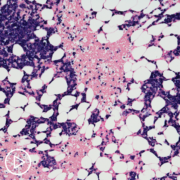How is Multiple Myeloma Staged?
How is Multiple Myeloma Staged? from Patient Empowerment Network on Vimeo.
How is staging used in multiple myeloma? Watch as expert Dr. Abdullah Khan explains staging and its use, and myeloma patient and Empowerment Lead Lisa Hatfield shares how the use of staging and its factors have evolved over time.
See More from START HERE Myeloma
Related Resources:

|

|
Transcript:
Healthcare professionals use a combination of lab test results, imaging tests, and bone marrow exams to determine the stage of multiple myeloma. The revised International Staging System or Durie-Salmon Staging System may be used in determining a patient’s multiple myeloma stage.
Dr. Abdullah Khan:
“The patients are assigned stages I to III. To determine the ISS you need lab values for the beta-2 microglobulin and albumin. For the revised ISS, you add on the lab value for LDH, lactate dehydrogenase, and you also add in the chromosome risk profile. So, there are certain genetic changes that predict a more aggressive myeloma. And the ones added to the revised ISS staging system are translocation 4;14, translocation 14;16, and deletion 17p.”
Lisa Hatfield:
So staging with multiple myeloma is really unique. A lot of times people think that every cancer has four stages. That is not true with myeloma. There are three stages for myeloma. And even now as of this year, some providers, some oncologists are not even staging myeloma. They’re looking at the risk factors, the cytogenetic risk factors to see if you’re standard risk or high risk. They’re not even using the staging system. It’s interesting. Back when I was diagnosed back in 2018, there were two staging systems used. One was the Durie-Salmon scale. I was diagnosed as stage III, which is the highest level. Mine was based on the fact that I had a lot of bone lesions and bone involvement.
But there’s also one called R-ISS, the revised ISS staging. And that one I was staged at stage I. So it’s really important to get a myeloma specialist on board quickly, because my myeloma specialist explained why I had two different stages I was staged at. She used the R-ISS, the more current system, the stage I and also looked at my cytogenetic risk factors. So your doctor will talk to you about FISH testing. And FISH testing might show something like translocations in the myeloma cells themselves or genetic abnormalities in the myeloma cells themselves. And that helps them dictate also what your risk will be going forward and how to treat that, how to treat your myeloma as a result of those risk factors and the stage you’re diagnosed at.
Your care provider may use other criteria in determining a person’s best optimal treatment. Make sure to ask if you have additional questions.




